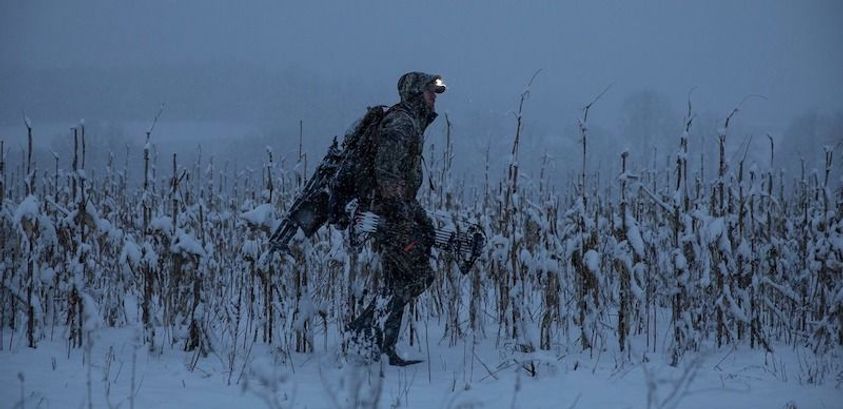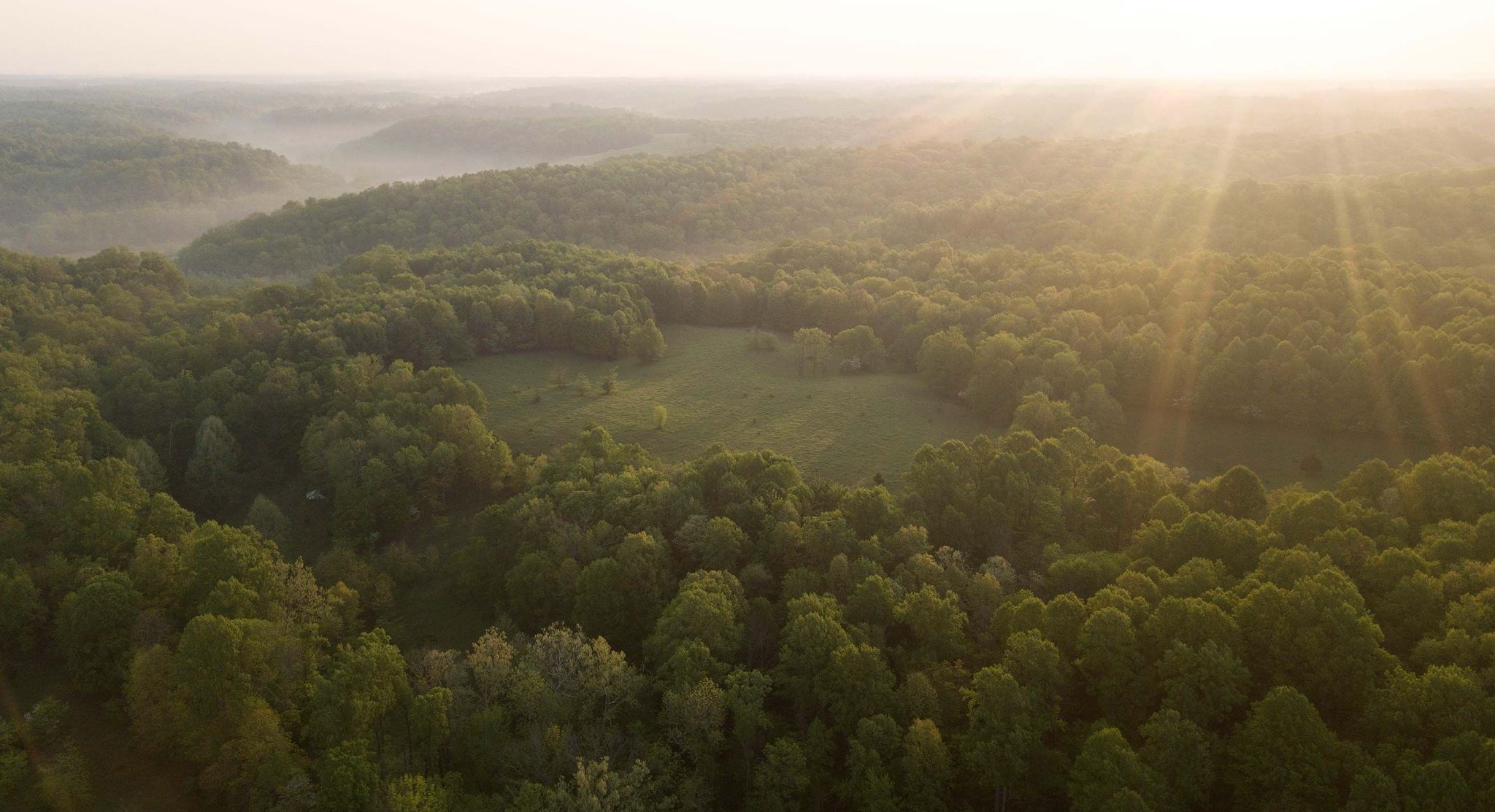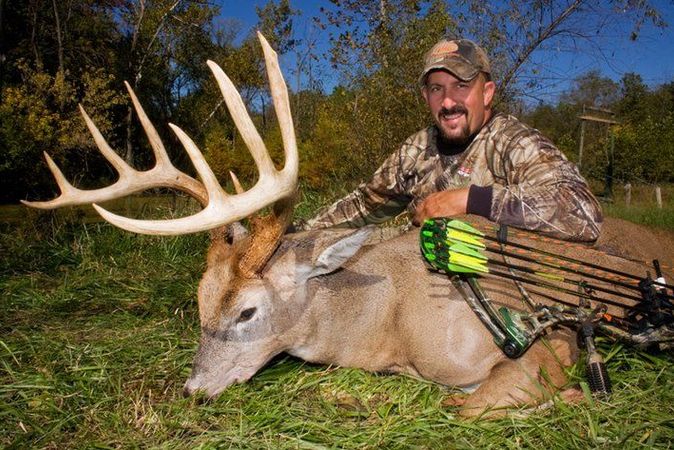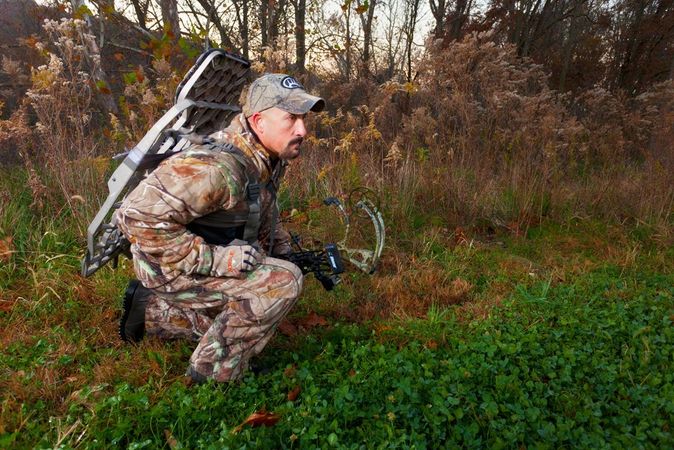Depending on where you hunt, late-season hunting can be bitterly cold. Often, deer hunters are sitting under snowcovered treetops and keeping eyes on clean, white fields of beans or corn. But this time of year affords advantages you don’t always get during other times of the hunting season.
Another nice thing about these last few weeks of deer season? They align with the holidays. Things slow down for many of us. Kids are out of school. And maybe you’re one of the lucky ones who’s looking to get a good chunk of time off for Christmas and New Year’s Day.
Use some of that time to get in the woods, if you can. And, when you do, keep these four things in mind.
Hunt the Food Sources

Yes, hunt the food. This we know. But why and what food?
First, the why: A reminder: deer are tired, and they’re hungry. They’ve been chased by hunters all fall, and they’ve been chasing does during the rut. Now, as they head into the harsh winter months, they need to replenish body weight and get healthy.
In a recent blog post, we offer some perspective on just how physically depleted bucks are after the rut. By tracking pre- and post-rut weights, studies found that bucks forgo feeding during the rut. According to the National Deer Alliance (NDA), “a buck can easily lose 20% to 25% of its body weight during the rut.” NDA also provided photos to illustrate the point — one photo was taken in early November, while another photo of the same deer was taken on December 25 — and the weight loss is clear.
As for types of food sources and which deer prefer most during this time of year, some of this calculation depends on what part of the country you’re hunting in. With that said, beans and corn tend to top our lists.
Our Land Specialists offer their preferences based on their own hunting experiences and the regions where they work, live and hunt. The key thing is to find high-protein food sources, says Pete Alfano, Whitetail Properties co-founder. “But if you’ve got standing beans, I mean, if I had one thing to hunt over, (it’s) late season, standing beans. You’re going to have all the deer in your neighborhood on your farm.”
Over in Kentucky, Land Specialists Mark Williams says, “when I hunt late season, food determines where I hunt, but weather determines when I hunt.” Williams looks for a major cold front to move through and, when it does, the bucks start moving. It’s then that you can count on mature bucks hitting those food sources during daylight hours.
Gabe Adair, who’s a Land Specialists in Iowa, prefers hunting standing grain during late-season deer hunting. “In southern Iowa and really Iowa in general, we have very good soil and we have a lot of soybean and corn,” he says. “In my opinion, there’s nothing that beats the two of them. If all things are equal, I’ll take corn any day of the week.”
Also, don’t overlook red-oak acorns during these last few weeks of the hunting season. While acorns produced by white oak trees are more palatable to deer and are targeted first by wildlife, red oak trees and their acorns provide critical nutrition for deer survival. As white-oak acorns become slim and picked over during late fall and early winter, deer will abandon those areas in favor of the red oaks on your property or hunting lease.
Patternable Deer Are Killable Deer
Dan Perez, one of our founding partners and host of Whitetail Properties television airing on the Sportsman Channel, will be the first to tell you that what’s cool about the late season is that deer come home. “Early in the rut period,” he says,” a lot of those bucks you were hunting in the early season, they’re gone. They’ve left. They’re hunting for hot does in other places.”
Many of us fear these bucks have been killed. But sometimes they’re just off doing what bucks do when the woods are crowded with does in estrus. During late-season deer hunting, hunters will often see these bucks again.
“And what’s really helpful,” says Perez. “You can pattern them.” Which is something you can’t do during the rut. Also by patterning late-season bucks, you can offset what your property may lack in food source.
“If you don’t have late-winter food sources on your property this season, hunt the trails leading to food on adjoining properties,” Perez says. “The deer will be moving from their bedding areas to feed when cold fronts come through. Get as close to the food source as you can. It will act as a funnel.”
Young Does in Estrus
During late-season deer hunting, especially if you’re hunting an area or region with abundant food sources, healthy doe fawns are entering estrus for the first time. These young does aren’t as stealthy as mature does. Often, thanks to youth, doe fawns in estrus lead bucks down well-used trails and open food sources, bringing mature bucks away from heavy cover during the late season.
Along with these doe fawns entering estrus for the first time, you’ll also have mature does who simply weren’t bred during the rut. After all, the rut is a narrow window. Typically, the number of does that go unbreed during the first cycle are few in number. But it happens. Those few does will cycle back into estrus about 28 days after peak rut, giving hunters what’s often referred to as a second rut.
Nocturnal No More
In the video below, Iowa Land Specialist Rich Baugh is looking out across a field planted in beans. This is the first time all year he’s sat this field. There’s snow on the ground. It’s late in the year. Wild turkeys forage in a stand of timber behind the bean field. Early in the hunt, does and a few young bucks graze. And soon, just a few frames into the video footage, a five-year-old buck comes into view.
Baugh tells his audience this buck is almost nocturnal. “I’ve hardly ever seen him,” he says. “I think this is the third time I’ve seen him in daylight, and I think we’ve only gotten footage of him once in all these years.”
During late-season deer hunting, it’s not unusual for hunters to begin seeing bucks they haven’t seen in daylight since early in the season. Or, in some cases like Baugh’s experience, mature bucks will show up late in the year that have only been spotted a time or two before.
Why? Often mature bucks pick and choose where and when they feed, and their preference is to feed in areas with good cover. Or, even, they elect to forage mostly in darkness. But as food sources thin, choices become limited and time becomes short.
Remember, these bucks are depleted. They’re coming off of the rut, and they’re heading into winter. It’s during the late season that largely nocturnal, mature bucks are forced to feed on limited, waining food sources along with the rest of the deer herd.
Resources
Interested in reading more about late-season deer hunting? If so, we’ve curated some of our most relevant articles and videos below:
Refining Late-Season Deer Hunting Tactics (Blog)
Late-Season Hunting Strategies (Video)
High-Percentage Treestand Placement for Each Phase of Deer Season (Blog)
Iowa Muzzleloader Buck, Late Season Deer Hunting (Video)
Featured Photo: Banks Outdoors






